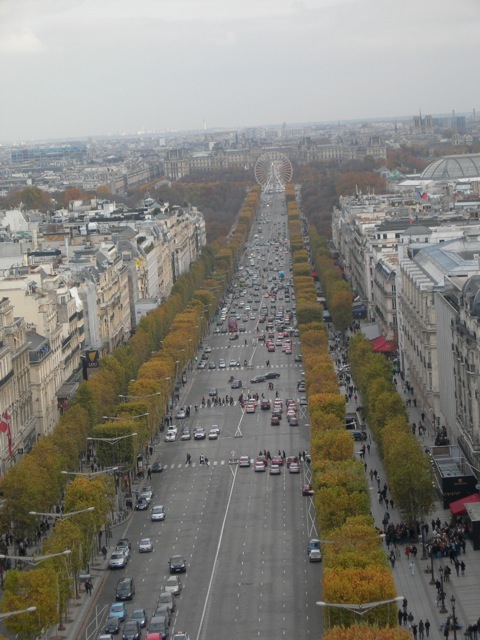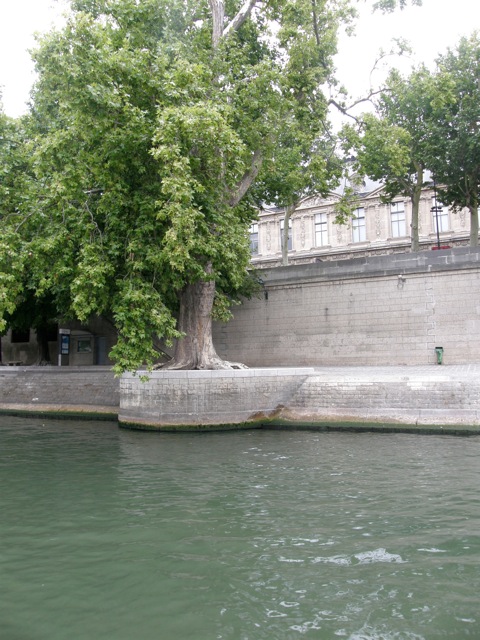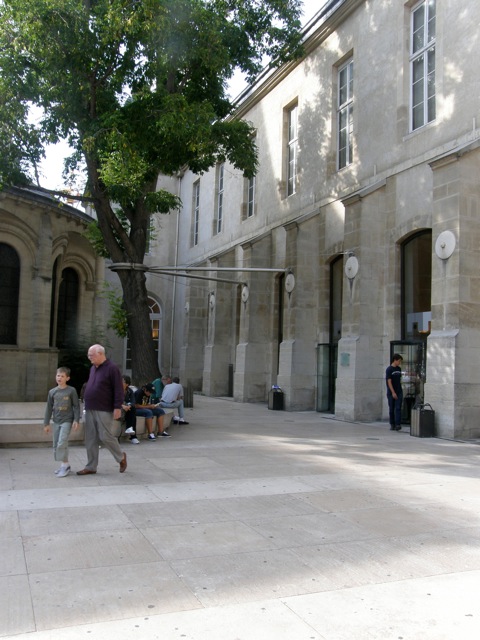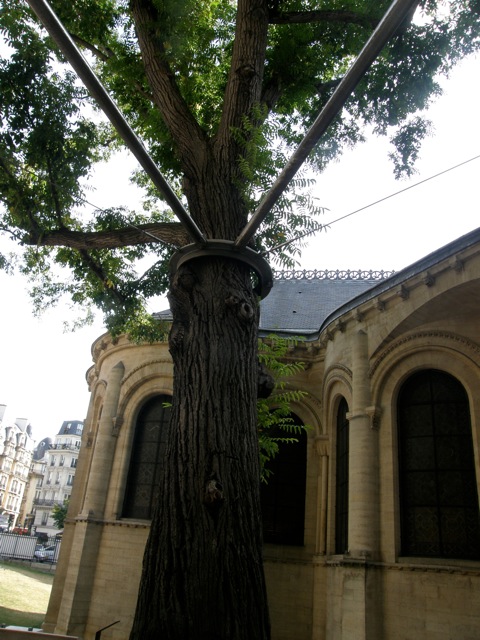Paris. City of light? Yes. Bridges? Indeed. Trees? Absolutely. The trees and their changing colours are one of the marvels of Paris. But it is no accidental marvel. Parisians work hard at maintaining their trees.
Paris abounds in small parks such as this. They are refreshing oases of calm and often elderly dignified beauty.
At street level, the Champs-Elysées seems awash in stores for all levels of ready cash and credit card limits. We are buffeted by a steady stream of tourists of all sizes, shapes, descriptions and dispositions and the sounds and sights of an endless stream of vehicles. It is easy to forget that the Champs Elysées is almost a wooded glade. As one stands on the top of the Arc de Triomphe, and looks along the Champs Elysées, it is the trees rather than the merchandising that stand out.
Paris’s trees often have to fight for our attention. The one shown below is certainly an attention grabber, and a reminder that trees have a finite lifespan. Some fall down. This tree in the Tuileries Gardens did not fall down. Called L’arbre des voyelles (the tree of vowels), it is a magnificent bronze sculpture by the Italian-born sculptor Guiseppe Penone. Born in 1947, his youth in the Piedmont forests gave him a love of nature and trees that one sees in his works of art.
Our discovery of L’arbre des voyelles was a quintessential Parisian moment. We return to it for calming renewal and to be reminded that the more you wander, the more Paris gives up its secrets. Only later would we realize that the same sculptor had created the striking wooden sculptures we love to show visitors we take to the Art Gallery of Ontario in Toronto. And yes, it is the same tree that has appeared at the top of every blog since we first started to write about the city.
Philippa and I first stumbled upon this extraordinarily realistic work of art quite by accident. We had crossed the river on the Passerelle Solferino and as we walked through the Tuileries Gardens we became aware of the apparently fallen tree. Aside from its beauty, two other things captivated us. It seemed so different from much of the geometric formality of French landscaping; Paris landscape designers are to be commended for exploring new forms. Second, it seemed so familiar, because at home in the Canadian woods and forests, we have often seen fallen trees with roots flailing at the sky.
Being a tree that lives to ripe old age in Paris often requires human commitment and sometimes rather heroic support.
As we drifted along the Seine on the Batobus (one of the best transportation bargains in the city), this tree stood out like a living punctuation mark to salute the beauty of the Seine and Paris. But the beauty was supported by the quayside extension that gave the tree a proper place to live and to grow.
In early November as we walked along the bank of the Seine near the Quai Henri IV, we were suddenly aware of some trees that seemed to arise out of the river as if they were floating.
As we got closer, we had to walk carefully, in order not to trip over the I-beams that were propping up the trees lest they fall over and end up floating or dipping into the water.
And it was thanks to the I-beams and the great care and pride of those who keep Paris a city of trees that several minutes later gave us this magical moment.
On a hot August afternoon, we were grateful for the shade afforded by a former church and this tree near the entrance to the Musée des Arts et Métiers (Museum of Arts and Trades/Technology).
The museum has stunning collections showcasing human ingenuity, skill, and imagination in areas such as instrument making, building technology, and transportation. It is also a fine place to eat. It is a popular museum and many visitors come through the doors or pause to sit in the shade and rest their feet. But how many pause to think of the engineering that helps to keep one tree upright and healthy?
How many look closely at the stainless steel ring circling the trunk about 4 metres above ground height? How many notice the cables and reinforcing stays that let the tree draw on the strength of the building? Or see the traces of the building itself having been reinforced?
Many of my photos start when changing light and reflections enter my consciousness. Without the tree, without the dedication and engineering that helps the Musée des Arts et Métiers tree stay alive and structurally sound, the reflections in the photo below would be less interesting. And without the carefully tended tree, Paris would have lost a precious asset.
I am grateful for the many ways Paris works to protect that which is rooted. While I might not be of Paris, while I am there I feel rooted. Rather like this chair on the rue St-Paul. One day, I may take up root at a café table myself.
Text and photographs by Norman Ball

































Thanks for sharing these amazing shots and insight.
This is a wonderful story. I have always enjoyed all the trees – and gardens – in downtown Paris. You chose a unique angle, however, and decided to highlight how hard the City of Paris works at keeping some of these trees healthy. Bonne journée! Veronique (French Girl in Seattle)
Enjoyed this article! Your floating leaf photo reminded me of a French artist in Saint Mammes who paints water and its reflections in her village as well as in Moret-sur-Loing. If you visit her website, http://www.claire-bianchi.com, I’m sure you will enjoy looking at her work. She and her husband also have a B&B behind her studio. Saint Mammes is a 45 minute train ride on the trainsilien commuter train network in and out of Gare d’Lyon.
What a wonderful post. It is wonderful to see the pride the Parisians take in the urban forestry. Wonderful photos too – that one tree with a ring around it seems so unusual! Thanks for sharing.
I just returned from Paris….I love the trees!~ but this post made me want to return and see them as you did. Wonderful post!!!
I can’t believe that my comment on this post has gotten lost – but I am not really surprised – I must have been SO captivated by the sky-view (well nearly!) of the Champs Elysées that I surely googled instantly the visiting timetable of the Arc de Triomphe (and forgot about it) – thus also loosing my comment….
Anyway, I am a great tree lover and tree hugger (when nobody is looking!!!) and that is ONE thing about Paris I absolutely ADORE – their parks, squares, gardens, green islands…. everywhere!
The ‘fallen tree’ also never fails to attract my renewed interest at every passing – and I fully agree with your saying that seeing Paris from the boat is just about the best way of visiting. Since we are here, I think I’ve taken just about every visitor on the 1h15′ trip on the bateau. I take them always from Pont Neuf because it’s convenient for us to get there and you are never disappointed by the spoken comments in English and French….
Might you be able to help me identify the trees in Place des Vosges? Any help would be appreciated.
We are not in Paris, so cannot help you immediately. However, you should consider making your question into a challenge for Adam Roberts of Invisible Paris. Go to http://parisisinvisible.blogspot.com/ and in the right-hand column, you will see the words “Challenge me!” Follow the link and ask him this question.
I do know that Paris has some very unusual trees that are rare or unknown in North America. I remember spending ages in a Paris bookshop trying to identify a particularly unusual one that was growing near an apartment we rented.
Rhea; I agree, Adam is your man – although he’s no gardener. I too am always amazed by the great care the Parisian authorities pay to their trees. They get even watered if necessary – regularly looked after, trimmed or cut back if needed – and they proudly look their best! Good luck 🙂
My son would probably be able to help, but he lives in the Swiss mountains where he works as a landscape gardener…
Thank you both so much for the instant reply. My second novel is set in part in Paris, and my protagonist is much more knowledgeable about trees than I am, so I need all the help I can get! Rhea